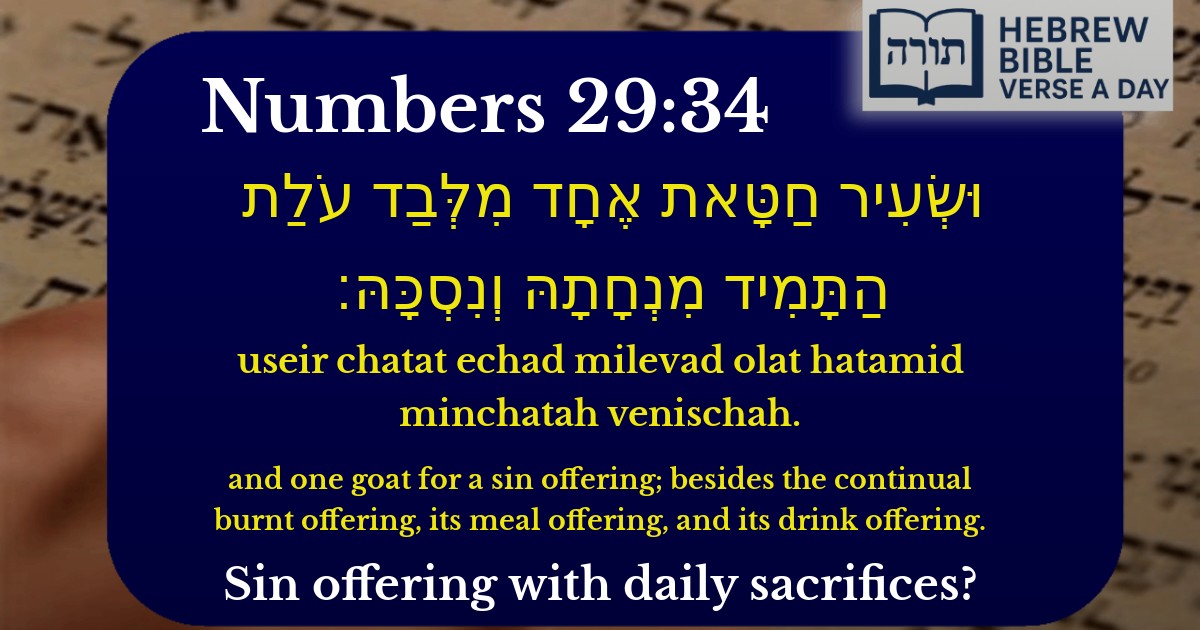Frequently Asked Questions
Q: What is the purpose of the sin offering mentioned in Numbers 29:34?
A: The sin offering (חַטָּאת) mentioned in this verse was brought to atone for unintentional sins. According to Rashi and the Talmud (Zevachim 7a), this offering helped purify the people and the Mishkan (Tabernacle) from impurities. The goat served as a means of repentance and spiritual cleansing.
Q: Why does the verse mention the continual burnt offering (עֹלַת הַתָּמִיד) alongside the sin offering?
A: The continual burnt offering (תָּמִיד) was a daily sacrifice brought morning and evening (Exodus 29:38-42). Rambam explains in Hilchot Temidin uMusafin that this offering symbolized the constant connection between the Jewish people and Hashem. The verse here emphasizes that even on special occasions, the daily offerings were not neglected.
Q: What do the meal offering (מִנְחָה) and drink offering (נֶסֶךְ) represent in this verse?
A: The meal offering (flour) and drink offering (wine) accompanied many sacrifices, including the burnt offering. The Midrash (Vayikra Rabbah 3:3) teaches that these offerings represent gratitude and dedication to Hashem. The flour symbolizes sustenance, while the wine represents joy in serving G-d.
Q: How does this verse relate to the Jewish holidays?
A: This verse appears in the context of the sacrifices brought during Sukkot (Numbers 29:12-34). The Talmud (Sukkah 55b) explains that the 70 bulls offered during Sukkot correspond to the 70 nations of the world, showing Judaism's universal concern. The additional sin offering mentioned here highlights the importance of atonement even during joyous festivals.
Q: Can we apply the lessons of this verse today without the Temple?
A: While we cannot bring sacrifices today, the Rambam (Hilchot Teshuva 1:3) teaches that prayer, repentance, and charity replace sacrifices. The verse reminds us of the constant need for spiritual connection (like the תָּמִיד offering) and atonement (like the חַטָּאת). Many Jews study the laws of sacrifices to prepare for the future rebuilding of the Temple.


Explanation of the Verse
The verse (Numbers 28:15) discusses the additional offerings brought on Rosh Chodesh (the New Moon), specifying that alongside the daily Korban Tamid (continual burnt offering), a sin offering of a goat (Se'ir Chatat) must also be brought. This reflects the unique requirements for atonement and sanctification associated with the beginning of each month.
Rashi's Commentary
Rashi (Rabbi Shlomo Yitzchaki) explains that the Se'ir Chatat (goat sin offering) is brought to atone for possible impurities in the Temple or among the Jewish people. He notes that this offering is distinct from the Korban Tamid, emphasizing that even on special occasions like Rosh Chodesh, the daily offerings are not neglected.
Rambam's Perspective
In Hilchot Temidin uMusafin (Laws of Continual and Additional Offerings), the Rambam (Maimonides) elaborates that the Se'ir Chatat serves as a communal atonement, ensuring the sanctity of the Temple service. He highlights that this offering is obligatory on Rosh Chodesh, underscoring the importance of maintaining purity in divine worship.
Midrashic Insights
The Midrash Tanchuma connects the Se'ir Chatat to the concept of renewal, as Rosh Chodesh symbolizes a fresh start. The goat offering serves as a reminder of human fallibility and the need for continuous repentance, especially at the onset of a new month.
Key Themes